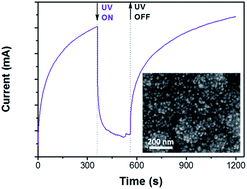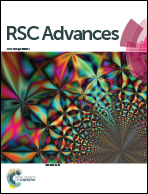Oxide planar p–n heterojunction prepared by low temperature solution growth for UV-photodetector applications†
Abstract
The paper presents the low temperature growth of a planar p-NiO/n-ZnO/FTO heterostructure for efficient detection of soft UV light. n-ZnO was prepared at 60 °C using an aqueous bath of zinc nitrate precursor. The 2D layer was uniform and well-covered the FTO substrate. NiO was electrodeposited on top of this layer at 90 °C in a dimethyl-sulfoxide (DMSO)-based electrolytic solution. The use of an aprotic solvent is shown to lead to the direct formation of nickel oxide. The p-type conductivity of NiO was demonstrated by the rectifying character of the heterostructure. The p-NiO/n-ZnO planar heterostructured-heterojunction demonstrated UV-photodetection properties with a good sensitivity under forward and reverse bias. A response SUV ≈ 2.46 at −1 V applied bias and a relatively low turn-on voltage of about 0.76 V were measured. The latter is much lower compared to turn-on voltages for other p-NiO/n-ZnO heterostructures reported in the literature. The elaborated method can serve as a new paradigm in simple and low-temperature deposition of type II heterostructures with large area and high separation efficiency for fabrication of high-performance optical devices, as well as for other types of applications such as gas sensors and catalysis.


 Please wait while we load your content...
Please wait while we load your content...